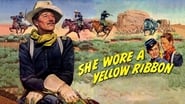dmh2-163-619355
Wayne turns in one of his finest patriarchal performances as aging Calvary Captain sent on final mission with little hope of success. Vivid cinematography is accented by a golden shimmer as warm as the characters in the story. A bit simplistic, but none the less effective. Like watching a monument come to life.
Wuchak
Released in 1949 and directed by John Ford, "She Wore a Yellow Ribbon" stars John Wayne as a captain near retirement who takes out a final patrol to alleviate an impending Native attack after tribes unite, emboldened by Custer's humbling defeat at Little Big Horn. Unfortunately, his duty is hindered by two women who must be evacuated from the fort, the younger one attracting the attentions of two junior officers (John Agar & Harry Carey Jr.). Ben Johnson has a significant role as a dependable sergeant. How do you review an old Western like this when you can't stand old-fashioned scores and hokey antiquated songs, not to mention the incongruent campy elements and slapstick (non)humor Ford is known for? Basically you have to ignore these factors and focus on the story and the actors. If you can do this, "She Wore a Yellow Ribbon" is worth checking out. Wayne was lean & mean at almost 42 (during shooting), but made out to be twenty years older for the role, while Dru was a striking hottie at almost 26. It's also cool seeing Johnson and Carey Jr. when they were so young. And the bright color photography really brings the film alive, particularly the gorgeous Monument Valley locations, unlike the flat B&W presentations of "Fort Apache" (1948) and "Rio Grande" (1950), the other two in Ford's cavalry trilogy. Amazingly, the film utilizes real Native Americans for the cast and the movie gets extra points for this and their respected, accurate portrayal. The film runs 103 minutes and was shot in Utah; Kayenta, Arizona; and California (studio). The screenplay was written by Frank S. Nugent & Laurence Stallings from a story by James Warner Bellah.GRADE: B-
jrpsm
Every viewing of this wonderful movie seems to reveal an interesting, purposeful detail, so small and subtle in its message,but unnoticed in previous viewings. For example, in the early scene where John Wayne is kneeling at his wife's grave, right behind him is another grave marker with the name B. DeVoto. Bernard DeVoto was one of our foremost historians of our western settlement. His "1846, The Year of Decision" is a classic. I can't help but think John Ford was trying to give DeVoto some recognition (that name is not one you just would not pull out the sky for a grave marker). Well, maybe that was a macabre way do it as DeVoto did not die until 1955, 6 years after the movie.Another interesting detail concerned the "indians" horseback riding. True western indians rode bareback mostly, but some had makeshift saddles. But none had stirrups. It's extremely hard to gallop a horse without stirrups. In this movie, where you had a direct view of the side of the Indian's horse, you could see that the indians were using stirrups, but they were camouflaged/covered with cloth. A lot of westerns don't go into that much detail.
Ilpo Hirvonen
Something inspired John Ford to make a cavalry trilogy in the late 1940's. It started in 1948 with Fort Apache, continued by She Wore a Yellow Ribbon, one year later, and the last of the trilogy Rio Grande (1950). The film in the middle, She Wore a Yellow Ribbon, was the only one shot in color and that is one of the things people remember it by. The gorgeous soulful images of the wild west gave Winton C. Hoch an Oscar for Best Cinematography. The reason why Ford decided to make the trilogy is simple; he and his crew took part in WWII which was an experience that changed his career for ever - all of his subsequent films would be about war in one way or another; no matter whether it was a comedy (The Quiet Man) or a ruthless western (The Searchers).An old captain Nathan Brittles is five days away from being retired but the death of 200 hundred soldiers lead him to his last mission. He's not sure what to do after he gets retired because the cavalry is where he belongs. He is in between of past and future, and is unable of talking about his feelings; except the monologues to the grave of his wife which represents direct discussion with history - the only time he feels as his own; the theme of aging was a very common theme for John Ford.She Wore a Yellow Ribbon is a nostalgic western characterized with beautiful images full of sentimentality about the past of a nation, history and presence. It's important to remember that a historic film is always a description of two different ages, intentionally or unintentionally, the age portrayed and the age the film was made in. John Ford's films of the cavalry trilogy are without a doubt allegorical tales of post-war States; meanings and feelings about the war. The trilogy most certainly isn't escapism that someone might easily think it is - the topic is very serious, history isn't the main topic - but the presence.The film is remembered for its soulful imagery, not just because of the beauty in them, but because they defined the film. She Wore a Yellow Ribbon speaks through images and sounds - not through the story. Sentimentality, emotions about yearning and loss, the dignity of recessive men are passed to the audience through sights and sounds - not through textual themes.The visual magnificence of She Wore a Yellow Ribbon really speaks to its viewer. The extraordinary, mythical, colors are like directly from a beautiful mural where small details just start to melt and lose their meaning - personal melancholy clearly exhales from these soulful sights and sounds.




